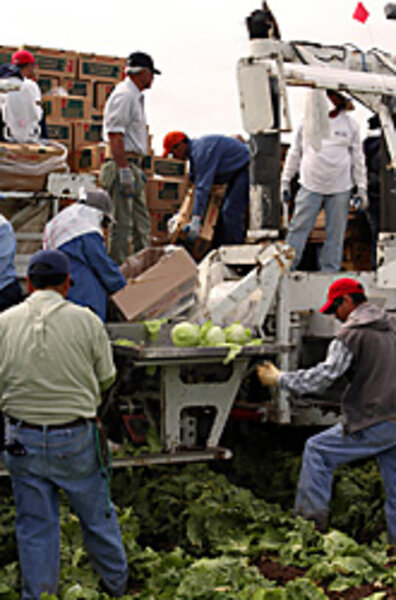Arizona considers a guest worker program of its own
| Phoenix
The state already at the cutting edge of immigration reform seems poised to undertake yet another experiment: a guest worker program created and administered by a state rather than by the federal government.
The Arizona legislature is expected on Monday to fast track bills to create a temporary worker program in the state. Even with the backing of top lawmakers, the bills face big hurdles, including sign-off from the feds. But if approved, they would streamline the process for Arizona employers to hire temporary workers from Mexico – and would serve as a model for national reform, say supporters.
At the same time, Arizona is pursuing a separate path to try to ensure that employers here, mainly in agriculture, have enough workers to bring in the crops. Gov. Janet Napolitano (D) is proposing that Arizona serve as a pilot for testing changes – some proposed by states bordering Mexico and others by US Labor Secretary Elaine Chao – to the existing federal program for granting visas to farm laborers from abroad.
Arizona already has the toughest employer sanctions law on the books – a possible reason, some experts say, employers are finding it more difficult to find an adequate number of workers now. Others, though, say that worker shortages here are chronic and that the real problem is lack of comprehensive immigration reform at the federal level.
Other states register similar complaints.
"We've heard from lawmakers around the country who are concerned" about flaws in the existing visa program for farm workers, says Sheri Steisel, an immigration policy expert at the National Conference of State Legislatures in Washington. "Other states are going to watch this Arizona effort."
Guest worker programs, of course, have a long history in the US. There was one during World War I and another, known as the bracero (strong arm) program, from World War II until 1964. The latter, critics say, led to massive immigration, both documented and undocumented.
Currently, the Department of Labor oversees a program created in 1986, dispensing H-2A visas for farm workers and H-2B visas for those in other industries. Government officials and analysts alike say the former is a bureaucratic morass and is little used by employers. On Feb. 6, the Labor Department proposed changes – the first in 20 years – to make the H-2A program more efficient. In a statement announcing the changes, the department acknowledged that "only a little more than 75,000 workers participate in the H-2A program, while there are an estimated 600,000 to 800,000 illegal immigrant workers on America's farms."
Changes include a procedure to more fairly calculate wages for foreign workers and ways to cut red tape, making it easier and swifter to hire foreign workers, particularly at harvest time. To protect domestic workers, the proposed changes increase the time employers would be required to recruit American workers before resorting to hiring foreign labor.
"The governor is glad [Secretary] Chao is considering changes," says Dennis Burke, chief of staff for Governor Napolitano, but is "not enamored" of a process that did not consult the states.
Arizona is home to a huge agricultural center at Yuma, where 80 to 90 percent of lettuce consumed in the US in the winter is grown. After meeting with farm workers and growers there, Napolitano wrote to Chao two days before the Labor Department's proposed changes were released. In her letter, she identified problems that "defeat the current H-2A program's stated purpose" and offered to lead an effort among border states to help revise the program.
Napolitano also backs in-state moves to create a guest worker program. Twin bills were first filed in February and have been gaining support. They are set to be reintroduced Monday with the Senate and House leaders as cosponsors. "With the leadership sponsoring, I expect the bills to fast track through," says Sen. Marsha Arzberger, the initial sponsor.
The measures would spare agricultural employers the arduous US approval process, Senator Arzberger says. Instead, an employer would send only one application, laying out the need for foreign labor, to the Industrial Commission of Arizona. If the commission certifies that Arizona lacks enough workers to fill the need, the employer can recruit in Mexico.
Prospective employees in Mexico go to the US consulate, undergo background checks, and, if certified to enter the US, receive employment cards to work in the US for two years, versus the 10 months now allowed under the federal program.
Lost in this discussion, critics say, is that the programs don't work.
"One argument made now about why we need a guest worker program is that it will end undocumented immigration," says Luis Plascencia, an expert on Mexican migration and guest worker programs at Arizona State University in Tempe. "It's the exact opposite. The bracero program and ensuing efforts stimulated illegal immigration…. Once migratory movements start, they become self-perpetuating."
Critics also cite a lack of enforcement, either against employers who abuse workers or workers who overstay their visas. The US government doesn't have the manpower or resources to do it now, experts say, and neither does Arizona.
While immigration policies give the impression that authorities have a handle on the problem, says John Garcia, an expert on public policy and immigration at the University of Arizona in Tucson, "there is a real problem with enforcement.





